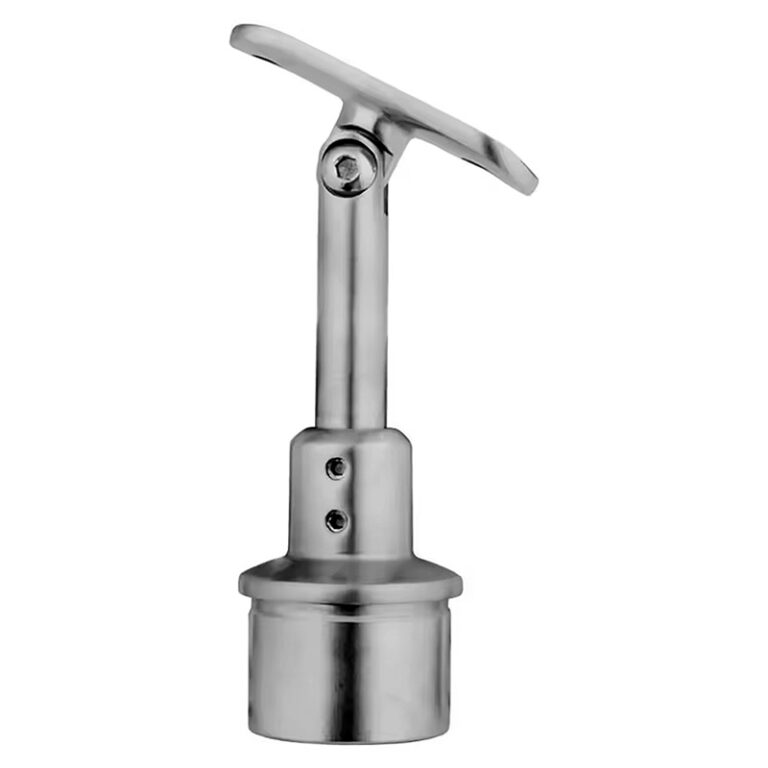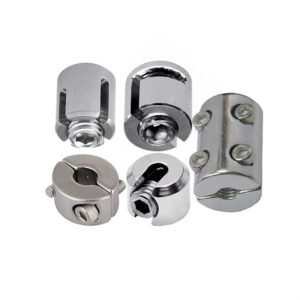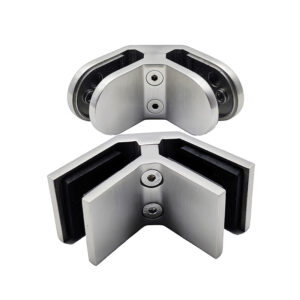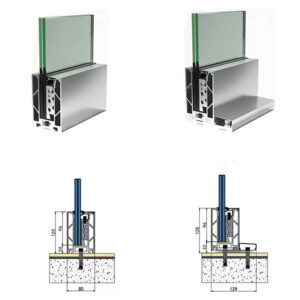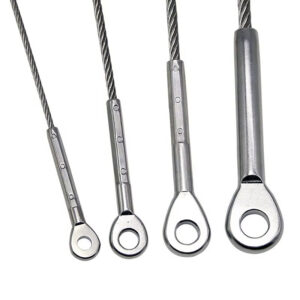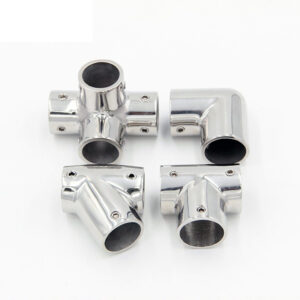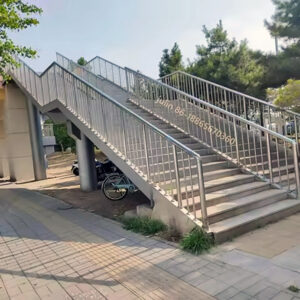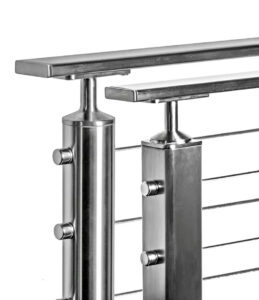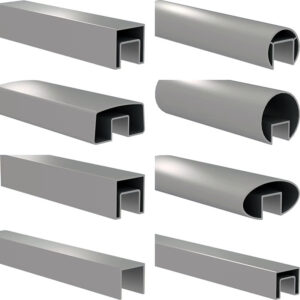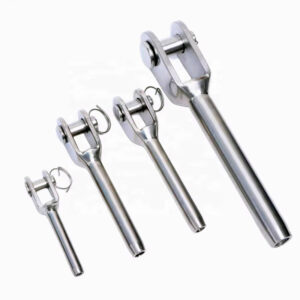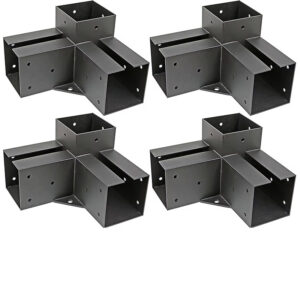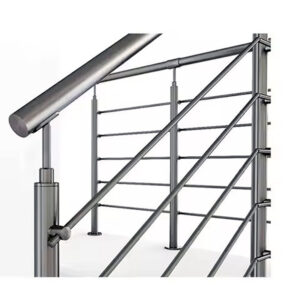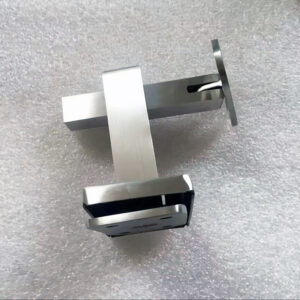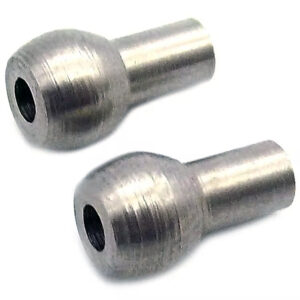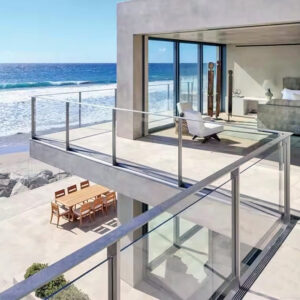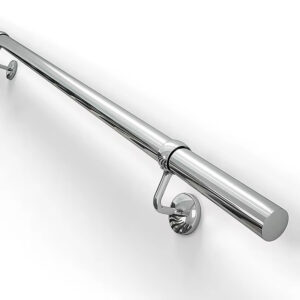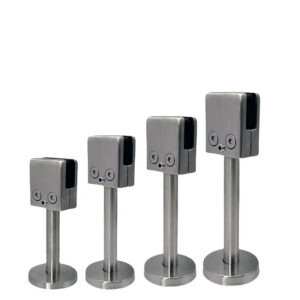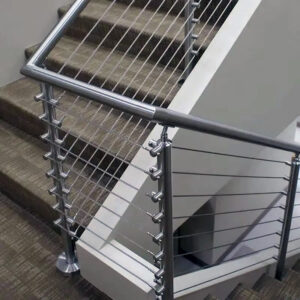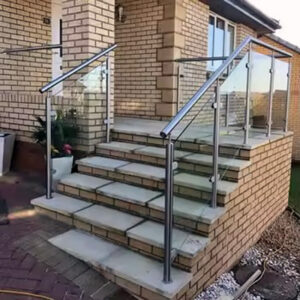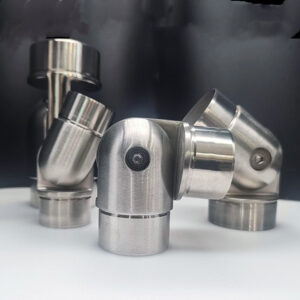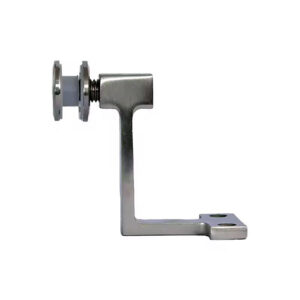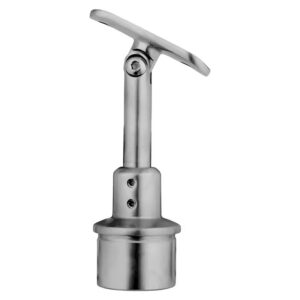Fixed-angle brackets create expensive problems: field modifications, code compliance issues, inventory nightmares, and installation delays that eat into project budgets. After 23 years manufacturing stainless steel railing hardware, we’ve seen contractors struggle with rigid systems that don’t adapt to actual site conditions. Variable angle brackets solve these problems with engineered adjustability that maintains structural integrity while simplifying installation across diverse applications.
Adjustable Railing Solutions That Work in the Real World
Core Variable Angle Systems
Wall-Mount Variable Brackets
Adjust from 0° to 180° for stairs, ramps, and multi-level installations. 304 and 316 stainless construction handles loads up to 350 lbs with consistent clamping force across the adjustment range. Pre-drilled mounting patterns fit standard wall anchors, reducing field preparation time.
Post-Mount Adjustable Hardware
Variable angle fabrication 316L systems for harsh environments where precise angles matter. Marine-grade alloys resist chloride corrosion while maintaining adjustment mechanisms that won’t seize over time. Custom angle locks prevent drift under dynamic loading.
Glass Panel Variable Clamps
Precision variable angle hardware that accommodates building settlement and thermal movement. Adjustable glass clamps maintain even pressure distribution while allowing ±15° adjustment without panel removal. Critical for commercial installations where building codes require specific glass positioning.
Cable Railing Variable Tensioners
Commercial variable angle systems that maintain cable tension across changing angles. Integrated swivel mechanisms prevent cable binding while threaded adjusters compensate for thermal expansion. Reduces maintenance calls and ensures consistent rail spacing.
Material Engineering for Durability
| Material Grade | Chloride Resistance | Cost Factor | Best Applications |
|---|---|---|---|
| 304 Stainless | Standard | 1.0x | Interior, low-moisture environments |
| 316 Stainless | High | 1.3x | Coastal, chemical exposure, marine |
| 316L Low-Carbon | Superior | 1.5x | Welded assemblies, extreme environments |
Variable angle brackets require precise tolerances to maintain structural performance across adjustment ranges. Our manufacturing process controls dimensional consistency within ±0.002″, ensuring smooth operation and reliable load transfer regardless of angle setting.
▶ Get Technical Specifications ◀
Load Performance Data
Real-world testing shows variable mechanisms maintain full load capacity across adjustment ranges when properly specified:
| Bracket Type | Static Load Rating | Dynamic Load Factor | Adjustment Range | Installation Time |
|---|---|---|---|---|
| Wall-Mount Variable | 350 lbs | 1.4x | 0-180° | 15 minutes |
| Post Variable Clamp | 275 lbs | 1.6x | ±45° | 8 minutes |
| Glass Variable Mount | 200 lbs | 1.2x | ±15° | 12 minutes |
| Cable Variable Tensor | 500 lbs tension | 1.8x | ±30° | 6 minutes |
Installation time estimates based on standard mounting conditions with pre-positioned anchors. Complex angles or field modifications may require additional time but eliminate separate fabrication costs.
Project Applications: Where Variable Angles Save Time and Money
Commercial Office Complex – Downtown Seattle
Challenge: Existing building renovation with non-standard stair angles and settlement-induced variations requiring code-compliant railings.
Solution: Marine grade variable brackets ODM solution accommodating 12° variation across three-story installation. Custom variable manufacturing delivered brackets pre-set to building survey measurements.
Results: 40% reduction in field modification time, zero code compliance delays, $15,000 savings versus custom fabrication alternative. Installation completed in 3 days versus 8-day estimate for fixed brackets.
Coastal Resort – Outer Banks, NC
Challenge: Salt air environment with complex deck angles, seasonal building movement, and strict hurricane load requirements.
Solution: 316L variable angle fabrication with sealed adjustment mechanisms and corrosion-resistant coatings. Variable brackets compensate for seasonal building movement while maintaining structural integrity.
Results: 5-year performance with zero corrosion issues, minimal maintenance requirements, and consistent code compliance through multiple inspections. Guest safety maintained through hurricane seasons with no bracket failures.
Industrial Manufacturing Plant – Phoenix, AZ
Challenge: Extreme temperature variations causing thermal expansion, multi-level catwalks with precise OSHA compliance requirements.
Solution: Commercial variable angle systems with thermal compensation features. Precision variable angle hardware maintains 42″ rail height ±1/4″ across 120°F temperature swings.
Results: OSHA compliance maintained continuously, reduced safety incidents, 60% decrease in maintenance-related production downtime. Investment recovered in 18 months through reduced maintenance costs.
“Variable angle brackets reduced our installation time by 35% and eliminated field welding on 80% of projects.” —National Association of Railing Contractors
▶ Discuss Your Project Requirements ◀
Installation Advantages That Impact Your Bottom Line
Simplified Field Work
Pre-engineered adjustment ranges eliminate most field modifications. Standard tools handle setup and adjustment, reducing specialized labor requirements. Modular components integrate with existing railing systems, minimizing inventory complexity.
Quality Control Benefits
Factory-set tolerances ensure consistent performance across installations. Esang Metal manufacturing precision eliminates field fit-up issues common with fixed brackets. Quality documentation supports code compliance inspections.
Supply Chain Efficiency
Variable brackets reduce SKU requirements compared to multiple fixed-angle options. Bulk ordering becomes practical when one bracket handles multiple applications. Just-in-time delivery supports lean construction schedules.
Long-Term Performance
Sealed adjustment mechanisms resist environmental degradation. Stainless construction maintains structural properties through thermal cycling. Predictable maintenance schedules reduce unexpected repair costs.
▶ Connect with Installation Support ◀
Frequently Asked Questions
Q: How do variable angle brackets maintain load ratings across adjustment ranges?
A: Engineering analysis verifies load paths remain consistent through mechanical advantage calculations. Critical stress points use reinforced construction with safety factors exceeding code requirements. Independent testing validates performance at extreme adjustment positions.
Q: What’s the maintenance reality for variable mechanisms?
A: Sealed bearings and corrosion-resistant materials minimize maintenance requirements. Annual inspection and lubrication sufficient for most environments. Marine applications may require semi-annual service. 23 years of field performance data shows 95% of mechanisms operate trouble-free for 10+ years.
Q: Can variable brackets work with existing railing systems?
A: Standard mounting patterns integrate with most commercial railing systems. Custom variable manufacturing accommodates proprietary connections when required. Compatibility verification available during design phase to prevent installation conflicts.
Q: How do costs compare with fixed bracket alternatives?
A: Initial cost typically 20-30% higher than fixed brackets, but installation savings and inventory reduction usually recover difference within first project. Elimination of field modifications and reduced labor requirements often result in net savings.
Q: What codes and standards apply to variable angle brackets?
A: IBC Section 1015, IRC Section R312, and AISI standards govern structural requirements. Variable mechanisms must maintain load ratings equivalent to fixed connections. Third-party testing verification available for critical applications.
Q: How quickly can custom angle requirements be manufactured?
A: Standard variable brackets ship within 5 business days. Custom variable manufacturing typically requires 2-3 weeks depending on complexity. Rush orders accommodated based on production capacity and project requirements.
Competitive Analysis: Making the Right Choice
| Feature | Variable Brackets | Fixed Multi-Angle | Field Fabrication | Welded Custom |
|---|---|---|---|---|
| Installation Speed | Fast | Moderate | Slow | Very Slow |
| Inventory Complexity | Low | High | Minimal | None |
| Field Flexibility | Excellent | Limited | Good | Perfect |
| Initial Cost | Moderate | Low | High | Very High |
| Long-term Value | Excellent | Good | Fair | Good |
Variable angle brackets excel when installation efficiency and long-term flexibility outweigh initial cost considerations. Fixed brackets remain cost-effective for high-volume, consistent-angle applications. Field fabrication makes sense only when angles exceed adjustment ranges or loads require custom engineering.
“Standardized variable hardware cut our project completion time by 25% while improving quality consistency.” —Commercial Contractors Association
▶ Get Project Pricing and Timeline ◀
Variable angle brackets represent 23 years of manufacturing evolution responding to real contractor needs. When installation flexibility, code compliance, and long-term performance matter more than minimum initial cost, engineered variable systems deliver measurable value. The question isn’t whether variable brackets cost more upfront—it’s whether fixed systems can afford the hidden costs of inflexibility.
